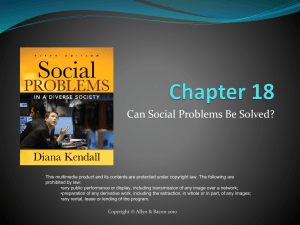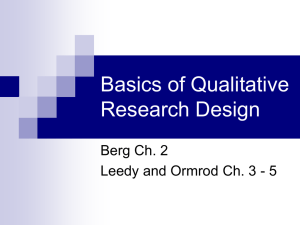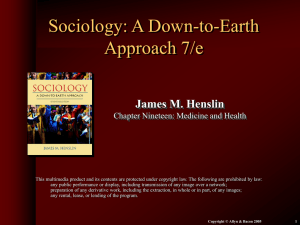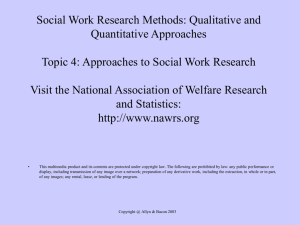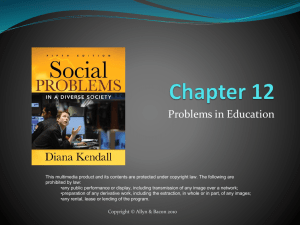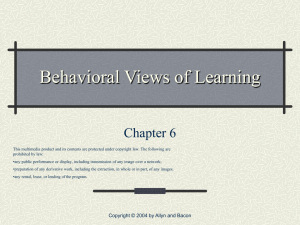chapter2_1_beebe
advertisement
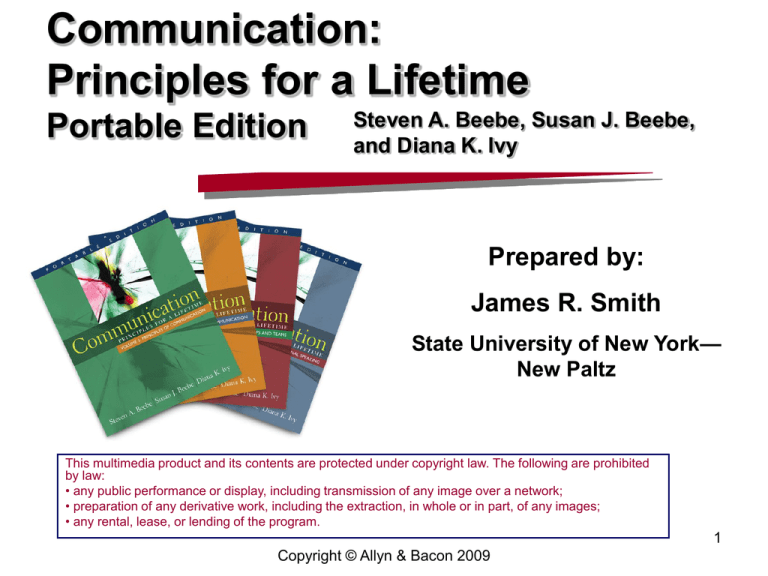
Communication: Principles for a Lifetime Portable Edition Steven A. Beebe, Susan J. Beebe, and Diana K. Ivy Prepared by: James R. Smith State University of New York— New Paltz This multimedia product and its contents are protected under copyright law. The following are prohibited by law: • any public performance or display, including transmission of any image over a network; • preparation of any derivative work, including the extraction, in whole or in part, of any images; • any rental, lease, or lending of the program. 1 Copyright © Allyn & Bacon 2009 VOLUME 2: INTERPERSONAL COMMUNICATION 2 Copyright © Allyn & Bacon 2009 CHAPTER 2.1 Understanding Interpersonal Communication 3 Copyright © Allyn & Bacon 2009 FIVE PRINCIPLES 4 Copyright © Allyn & Bacon 2009 INTERPERSONAL COMMUNICATION • Interpersonal communication—is communication that occurs with another person in an attempt to mutually influence each other, usually for the purpose of managing relationships. 5 Copyright © Allyn & Bacon 2009 WHAT IS INTERPERSONAL COMMUNICATION? • Interpersonal involves quality. – Impersonal communication treats people as objects. • Interpersonal involves mutual influence. • Interpersonal helps manage relationships. – A relationship is an ongoing connection made with another person. 6 Copyright © Allyn & Bacon 2009 INITIATE & MAINTAIN RELATIONSHIPS • Interpersonal communication serves to… INITIATE RELATIONSHIPS MAINTAIN RELATIONSHIPS Relationships are ongoing connections made with another person. 7 Copyright © Allyn & Bacon 2009 RELATIONSHIP TYPES • RELATIONSHIP OF CIRCUMSTANCE – Relationship that forms situationally, one life overlaps another in some way. • RELATIONSHIP OF CHOICE – Relationship that is sought out and intentionally developed. 8 Copyright © Allyn & Bacon 2009 INTERPERSONAL ATTRACTION • A good place to start exploring the process of initiating relationships is via examining the nature of attraction. Attraction is a motivational state causing someone to think, feel, and usually behave in a positive manner toward another person. 9 Copyright © Allyn & Bacon 2009 ELEMENTS OF ATTRACTION SHORT-TERM ATTRACTION LONG-TERM ATTRACTION SIMILARITY PHYSICAL ATTRACTION SEXUAL ATTRACTION PROXIMITY COMPLEMENTARITY 10 Copyright © Allyn & Bacon 2009 MATCHING HYPOTHESIS • The matching hypothesis is a tendency to seek out individuals who represent the same level of physical attractiveness as oneself. 11 Copyright © Allyn & Bacon 2009 INTERPERSONAL NEEDS MOTIVATE RELATIONSHIPS • Social psychologist Will Schutz identified three interpersonal needs motivating us to form and maintain relationships. – Inclusion – Control – Affection 12 Copyright © Allyn & Bacon 2009 COMMUNICATING ATTRACTION • We use both indirect and direct strategies to communicate our liking via verbal and nonverbal cues. • Immediacy refers to feelings of liking, pleasure, and closeness communicated by such nonverbal cues as eye contact, touch, and open body orientation. 13 Copyright © Allyn & Bacon 2009 THAT FIRST CONVERSATION • Online and face-to-face (FtF) encounters are different. • Some practical suggestions – Reduce uncertainty – Find something you have in common – Ask great questions – Give/receive compliments 14 Copyright © Allyn & Bacon 2009 REDUCING UNCERTAINTY • Passive strategy involves observing others and situations to reduce uncertainty. • Active strategy involves acquiring information from a third party. • Interactive strategy involves communicating directly to the source who has greatest potential to reduce uncertainty. 15 Copyright © Allyn & Bacon 2009 TALK ABOUT YOURSELF TOO MUCH? • Conversational narcissism is a style of communication that emerges from the view that you are the center of the universe. • Self-absorbed style is a dominating communication style in which one focuses attention on the self. 16 Copyright © Allyn & Bacon 2009 POSITIVE ACTIONS • Practice the art and skill of asking great questions. • Practice the art and skill of giving and receiving compliments. – Giving compliments is tricky. Some attempts at flattery can be taken the wrong way. – Consider male/female relations in the workplace. 17 Copyright © Allyn & Bacon 2009 MAINTAINING RELATIONSHIPS • Many interpersonal communication forms are necessary to maintain successful relationships. • Self-disclosure and expressing emotions are particularly important. 18 Copyright © Allyn & Bacon 2009 MAINTAINING SELF-DISCLOSURE • Self-Disclosure is the process of voluntarily providing information to others that they would not learn if you didn’t tell them. • Appropriateness aspect of self-disclosure regarding the propriety of information. • Reciprocity is sharing information about oneself with the expectation that the other person will also share information similar in risk or depth. 19 Copyright © Allyn & Bacon 2009 20 Copyright © Allyn & Bacon 2009 21 Copyright © Allyn & Bacon 2009 EXPRESSING EMOTIONS • Expressing emotions is another powerful way we reveal ourselves to deepen relationships. • As relationships become more intimate, expectations that a partner will openly disclose emotions increase. • Emotional expression varies by culture. 22 Copyright © Allyn & Bacon 2009 STUDY HINTS • Read Chapter Summary and Recaps • Know terms in boldface and definitions • Review communication elements in initiating and maintaining relationships • Study elements of interpersonal attraction and uncertainty reduction. 23 Copyright © Allyn & Bacon 2009


